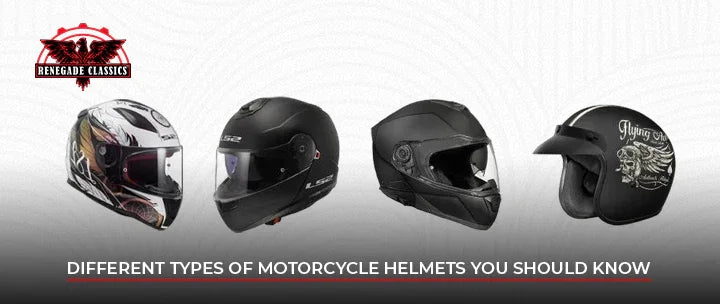Have you ever thought about it, "why some riders prefer sleek full-face helmets while others go for the classic open-face look?". Choosing the right helmet isn’t just about style; it’s about safety, comfort, and staying road-ready. In a 2024 Consumer Safety Report, 82% of riders said their helmet was the single best safety feature they trusted. With dozens of styles on the market, finding the perfect fit can feel like choosing a name from a crowded contact list.
Using Advice from both beginner riders and experienced riders, we’ve broken down all types of motorcycle helmets, from cutting-edge modular designs to timeless vintage lids. By the end of this guide, you’ll understand what distinguishes full-face, modular, open-face, half, off-road, and dual-sport helmets, and know exactly which one makes sense for your riding style.
1. Full-Face Motorcycle Helmets

Full face motorcycle helmets are known for their safest style because they protect you and cover your whole head, front of your head, back of your head, sides, and chin. Includes internal sun visors, dual vents for ventilation, and aerodynamic shells, which are perfect for high-speed riding, cold weather, and long-distance touring. According to research, helmets significantly reduce head injury risk by around 69%, especially full-face designs.
Features:
-
A solid chin bar
-
Aerodynamic shell
-
Sun visor
-
Multi-point ventilation
-
Padded interior for comfort
-
Offers full-face coverage
-
Noise reduction.
Purpose: They are crafted to offer security for the whole head and facial area in an accident, reduce the noise of the road and wind, and defend against cold weather. It is tailored for high-speed, safe, long-distance, and all-weather riding.
2. Modular (Flip‑Up) Helmets

It is a combo of both full-face and open-face designs, giving riders the convenience of both. They are a highly preferred for touring and adventure enthusiasts who need versatility on long or unpredictable rides.
Features:
-
A hinged chin bar that lifts up
-
Internal drop-down sun visors
-
Wide face shields
-
Efficient ventilation systems
-
Few models also support Bluetooth integration and eyeglass-friendly interiors.
Purpose: These helmets are crafted to increase rider convenience without compromising protection, perfect for quick stops, easy interaction, and smooth transitions between city and highway riding.
3. Open‑Face (3/4) Helmets

Experts say, "helmets decrease the risk of head injury by 69%, but not all helmets provide the same level of coverage". Open-face helmets will cover three-quarters of your head, have become a staple among city riders and cruisers who prioritize visibility and comfort over full-face protection. Whereas it also leaves the chin exposed, their popularity remains strong due to their lightweight build and ease of use.
Purpose:
These Open‑Face 3/4 Helmets are best for low-speed city commuting, short-distance travel, and riders who enjoy an open view and airflow without giving up essential head protection.
Features:
These helmets typically include
-
Extended ear coverage
-
Large visors or face shields for eye protection
-
Padded interiors
-
Compatibility with Bluetooth systems.
-
They are lightweight and have an open design, which makes them a favorite for warm weather and relaxed rides.
4. Half Helmets

Half helmets, also known as brain buckets, are the lightest and most minimal form of motorcycle head protection. According to the Experts (IIHS), they provide the least coverage but remain popular among cruiser and chopper riders for their unmatched sense of freedom and airflow.
Purpose:
They are perfect for short rides, warm weather, and low-speed cruising. Also, Half helmets are chosen by riders who want basic protection without the bulk of full-coverage designs.
Features:
-
These helmets cover only the top of the head
-
Having adjustable chin straps
-
Minimalist padding,
-
Detachable visors.
-
Some models also offer quick-release buckles, speaker-ready ear pads, and retro-inspired styling for a custom look.
5. Off-Road / Motocross Helmets

Off-road helmets are specifically designed to track the dirt and rugged terrains, where traditional street helmets fall short. The study says, "Motocross injuries commonly affect the head and face, making specialized helmets crucial". These helmets are designed for impact protection, breathability, and visibility during aggressive riding conditions.
Purpose:
Built for dirt biking, motocross, trail riding, and enduro racing, off-road helmets focus on maximizing protection, ventilation, and performance in challenging outdoor environments.
Features:
-
They include an extended chin bar for ventilation and defense from scraps.
-
A sun peak visor to block glare and roost
-
Lightweight shells for reduced fatigue.
-
Most models demanded to be worn with goggles instead of a built-in face shield, enhancing eye protection in dusty or muddy conditions.
6. Dual‑Sport / Adventure Helmets

Dual-sport helmets are the ideal fusion engineered for exploration, designed for ease. According to Motorcycle Experts, adventure riders sometimes face both street and dirt, requiring a helmet that adapts to changing weather. That’s where dual-sport helmets shine, providing flexibility, visibility, and ventilation all in one design.
Purpose:
Dual-sport helmets/adventure helmets are crafted for riders who switch between highways and trails. These helmets offer the tough features of off-road gear with the comfort and protection required for street riding.
Features:
They feature a built-in face shield,
-
Extended chin bar for airflow
-
A sun visor similar to off-road helmets.
-
Whereas original dirt helmets offer better sound insulation and are compatible with goggles or integrated visors, making them ideal for adventure touring and mixed-terrain exploration.
7. Vintage / Classic Helmets

Vintage or classic motorcycle Helmets are back in style, especially among café racer and retro bike enthusiasts. While they reflect the charm of mid-20th-century riding, many modern versions now meet DOT or ECE safety standards, blending old-school looks with today’s safety expectations.
Purpose:
These helmets are designed for riders who prioritize timeless aesthetics and a minimalist feel, often used for casual city cruising, classic bike shows, or low-speed weekend rides.
Features:
-
Simple shell designs
-
Leather or suede interiors
-
Classic colorways.
-
Some models offer modern upgrades like
-
Lightweight fiberglass shells
-
Removable liners
-
Compatibility with vintage-style visors or goggles.
8. Smart Helmets

Smart helmets are becoming more essential in motorcycle safety by combining advanced tech with solid security. With more riders looking for real-time updates and make connectivity, it's no surprise that the global smart helmet market is on the rise. Even Experts report a major growth trend fueled by the push for safer, smarter riding gear.
Purpose:
Designed for tech-savvy riders, smart helmets enhance road awareness, communication, and convenience, ideal for touring, commuting, and safety-conscious motorcyclists.
Features:
-
They often include built-in Bluetooth
-
GPS navigation
-
Rear-view cameras
-
Voice control
-
Heads-up displays (HUD)
-
Crash detection
-
Smartphone integration.
-
Some models also feature noise cancellation
-
Anti-fog visors
-
App connectivity for ride data tracking.
9. Off-Road e-Bike & Scooter Helmets

With the increase of electric mobility, off-road e-bike and scooter helmets are becoming crucial for safe riding on unpaved trails and rugged paths. According to the Motorcycle experts, electric-bike accidents have increased in recent years, most probably off-road, making proper headgear more critical than ever.
Purpose:
These helmets are built for riders tackling dirt tracks, forest trails, or uneven terrain on electric bikes and scooters. They prioritize shock absorption, ventilation, and extended coverage for low- to mid-speed crashes.
Features:
-
Typically lightweight yet rugged
-
They offer extended rear head coverage
-
Integrated visors or goggle compatibility
-
Enhanced ventilation systems
-
Adjustable fit systems.
-
Many are CPSC or EN1078 certified, balancing safety with comfort for e-adventures.
10. Racing & Track-Spec Helmets

When speed becomes high, racing and track-ready helmets will become your Top-of-the-line for defense. According to Experts, these helmets undergo rigorous testing to withstand high-speed impacts, making them the top-pick choice for professional racers and track-day enthusiasts.
Purpose:
Racing & Track-Spec Helmets are for good-performance environments. These helmets are built to protect riders at extreme speeds while enhancing aerodynamics, visibility, and comfort under pressure.
Features:
-
They boast ultra-lightweight composite shells (carbon fiber or fiberglass)
-
Advanced ventilation channels
-
Double D-ring fasteners
-
Tear-off-ready visors
-
Race-approved aerodynamic spoilers.
-
Most are FIM or Snell certified, meeting the strictest safety standards for competitive use.
Helmet Safety Standards to Know
Don’t skip this, every trusted helmet carries at least one of these certifications:
|
DOT (U.S.) |
Baseline protection against impacts and penetration. |
|
ECE (Europe) |
Covers durability, visor strength, and shell rigidity. |
|
SNELL |
Voluntary, rigorous tests favored by racers. |
|
FIM FRHPhe-01 |
High-performance standard for professional competition. |
Certified helmets undergo strict impact and shell tests, visibility requirements, and quality controls; they’re the only helmets you should trust.
Quick Comparison Guide for Helmet
|
Helmet Type |
Coverage |
Ventilation |
Weight |
Best For |
|
Full-Face |
Full head & chin |
Moderate |
Medium |
Highway, track riding, and cold weather |
|
Modular |
Full w/ flip chin |
Moderate |
Slightly Heavy |
Touring, commuters need flexibility |
|
Open-Face (3/4) |
Top/back/sides |
High |
Light |
Vintage style, city cruising |
|
Half |
Only crown |
Very High |
Very Light |
Short rides, sunny weather |
|
Off-Road/Motocross |
Chin + skull |
Very High |
Light |
Dirt paths, motocross |
|
Dual-Sport |
Chin + skull + bar |
High |
Medium |
Mixed terrain use |
|
Vintage/Classic |
Top/back/sides |
Low |
Light |
Retro style, low-speed leisure |
|
Smart Helmet |
Varies |
Varies |
Varies |
Tech-forward touring, daily convenience |
|
Racing / Track |
Full face |
High |
Ultra-light |
Pro track, high-speed events |
How To Choose the Right Helmet?
Selecting the right motorcycle helmet isn’t just about looks, but also making a decision to prefer a protected helmet that will play a crucial role in your security and comfort every time you go out on the road for a ride. From how it will fit to the features it offers, every detail is essential. This article is to help you find a helmet that meets all your requirements.
Fit: The most essential part of helmet shopping is to prefer a fitting because a loose helmet won’t protect you the way it should in an accident, and on the other hand, a helmet that is too tight
can give you a headache before you finish your ride.If you want to know how to get the right size, then... you have to wrap tape measure around your head, just above your eyebrows and ears, and compare it to the brand’s sizing chart. Since each brand fits a little differently, always go by the specific chart for the helmet you’re looking at.
Comfort: For long journey rides, you want a helmet that feels good hour after hour. If you are looking for soft interior padding that contours to your head without creating pressure points. A good ventilation system is just as important; it helps with airflow to keep you cool and cuts down on visor fog so you can ride with a clear view.
Pick the Right Helmet for the Ride
What kind of riding do you do most?
-
Off-roading? Choose a dirt or dual-sport helmet with top-tier ventilation and dust filters.
-
Highway or track days? A full-face helmet with aerodynamic design and full coverage is the best pick.
-
Cruising around town? Go for a modular or open-face helmet that’s easier to slip on and off.
Match your helmet to your lifestyle and riding style; it’ll make a big difference.
Features:
Modern helmets are more advanced than ever. Some popular add-ons include:
-
Built-in Bluetooth for communication or music
-
Drop-down sun visors for bright days
-
Quick-release chin straps for easy removal
-
Anti-fog visors and closable vents for all-season riding
Not all rider needs every feature, so think about what will actually improve your ride and invest in that.
Final Thoughts
Each type has its own story and purpose, starting from basic half-shells to high-tech smart helmets. Even if you're after protection for long rides, retro flair, or smartphone-level connectivity, there's a perfect lid out there. Start by understanding what are the different types of motorcycle helmets, then match your choice with your riding style.
Your head’s worth it, choose wisely, ride safe.








